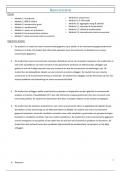Chapter 2 custom edition:
Nationalism and the origins of the EU:
Ideas of a unified Europe can be traced back to the 17 th century.
Germany and France only began to have some form of
nationalism to the end of the 19th century. After the two world
wars a lot could be contributed to them by the aggressive and
external effects of nationalism.
The sentiment after the second world war was that there had to
be a way to solve and organize international affairs to reduce,
eradicate, a conflict of this magnitude. This is the reason why
the UN was established
Founding of the EEC: the Resistance movement supported the
idea of a united Europe, to replace the destructive forces of
nationalism. However, after the electoral defeat of the EU
proponent Churchill, the unification faltered. Nonetheless, there
were many countries which moved towards European
cooperation, eg. The Marshall Plan for the support of the
economic European growth, then the Organisation for
Economic cooperation and development , NATO for cooperation
in defense and the WEU (Western European Union).
,The Council of Europe was signed in 1949 and is best known for
the human rights convention (ECHR), which was signed in 1950
and came to force in 1953. We can here see more concrete
moves towards the founding of the EEC.
Due to the fact that the UK was unwilling to participate in plans
for European Integration, the German and French government
decided to administer their coal and steel to an international
agreement in which supervisory authority was given to a body
termed the High Authority. The proposal was made in such a
way so that other countries could join. The focus of coal and
steel was partly economical but mainly political because these
sources have been the main characters of a lot of wars and
dispute. They are also used for the military. When Germany
puts these sources to an international force, they ensure that
they will not make use of it for national enforcement of the
military.
The European Coal and Steel Community (ECSC) Treaty was
signed in 1951 by France, Germany, Italy, Belgium,
Netherlands, and Luxembourg. It had a lifespan of 50 years to
expire in 2002, and established a common market in coal and
steel. There were four principal institutions.
1) The High Authority, composed of nine independent
appointees of the six Member State governments, was the
main executive institution with decision-making power
2) an Assembly made up of national parliaments’ delegates
had supervisory and advisory powers;
, 3) a Council composed of a representative from each national
government had limited decision-making powers and a
broader consultative role;
4) the Court of Justice composed of nine judges.
Although the remit of the ECSC was limited to coal and
steel, its proponents always saw it as a supranational
authority, in which the High Authority could adopt
decisions other than by unanimity, which could then serve
as the first step towards broader European integration
Setbacks in the integration-process
- European Defence Community (EDC)
- European Political Community (EPC)
To establish a form of a European army, there needed to be a form of
common European foreign policy and the establishment of this would be
tightly linked to that of the EPC. The EPC had a draft of a bicameral
parliament and would’ve had real legislative power (with one chamber
being elected by suffrage and the other by national parliaments). Because
of the fact that both communities were in constitutional sense tightly
linked to each other, they both went down to political criticism from
France. There was also a lot of criticism from the ministers of the ESCS on
the parliament which would have a great deal of parliamentary power.
The failure of a EPC and EDC led to focus on the economic side of unity
rather than political. The Netherlands came with an offer for an European
common market in which the participating countries could trade freely
with eachother. This was, for the time being, a fairly groundbreaking idea
because of the fact that a lot of countries were still protectionist. The focus
was economical, although the underlying long-term initiative was political.
, The main focus of the common market was the removal of stiff barriers,
such as tariffs.
It also entailed the free movement of the economic factors of production in
order to ensure that they were being used most efficiently throughout the
Community as a whole. This explains the centrality to the Community of
the ‘four freedoms’, which are often regarded as the core of its economic
constitution: free movement of goods, workers, capital, and establishment
and the provision of services. If someone couldn’t find a job in one EEC
country because of high employment levels, this person can easily move
to another EEC country and thus the value of labor within the Community
could be enhanced.
Treaty of Rome was in addition signed to enhance the economic
policies of the Member States, to promote harmonious development of
economic activities throughout the Community, to increase stability and
raise the standard of living and to promote the relations between the
Member States.
There were common policies in agriculture and transport. A European
Social Fund was established to improve employment opportunities and an
Investment Bank, to give loans and guarantees and to help less developed
countries and sectors. A European Development Fund for overseas
countries and territories of some of the Member States was also
established.
The EEC created a separate Council of Ministers consisting of a national
representative from each Member State, which represented its interest in
the Council and a SEPARATE EXECUTIVE AUTHORITY, The Commission,
which was composed of members drawn from the Member States, who
had an obligation of independence and who were to represent the
Community rather than the national interest.



